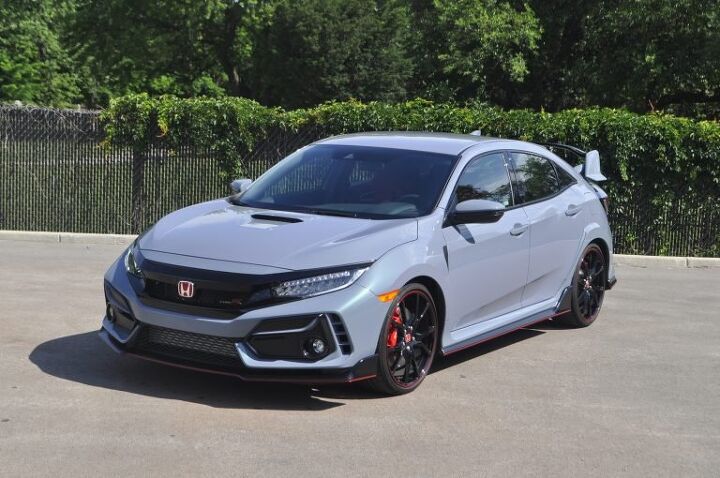2020 Honda Civic Type R Review - Changed But Unaffected

2020 Honda Civic Type R Fast Facts
The last time your humble scribe traveled on an airplane to test drive a new car in some location that is “not here” was just over a year ago. That vehicle was the Honda CR-V Hybrid.
While in Tucson, Honda reps told us to keep an eye on our inboxes for an upcoming drive of the updated Civic Type R. This raised my eyebrows, as I knew the changes to the Type R for 2020 were fairly mild, though they did promise some improvements to the already excellent driving dynamics.
Still, I’d not turn down too many chances to drive what might be the best high-performance compact car one can buy today.
Of course, COVID binned that trip, along with most others. So instead, a Type R ended up in my garage for a week.
There’s not much I can say about the Type R that I haven’t said already, and while some of the changes are meant to improve the car’s performance, the differences are so subtle that it might require a trip to the track to sort things out. I certainly didn’t notice much difference, positive or negative, on public roads.
It remains a hoot to drive, with swift acceleration that is mostly unaffected by torque steer – a neat trick in a high-powered front-drive machine. It still carves corners in a manner reminiscent of racing machines, with accurate and direct steering that is rarely seen on street cars. It still has a clutch/shifter relationship that makes the gearbox a joy to row.
It also still rides stiffly, has a cheesy boy-racer cabin to go along with cheesy exterior boy-racer looks, and the rear wing is still a source of embarrassment when you’re trundling about town.
Those flaws annoy, and along with the sticker price, it makes the compact sport-sedan intender who intends to daily drive their purchase start thinking about cars that offer 75 percent of the performance for a less-dear price. Honda’s Civic Si – currently on hiatus for 2021, awaiting the next-gen Civic – or the Volkswagen Jetta GLI, for example.
But those with stout backs and the inability to shrug off jokes about overcompensation can still daily this thing.
Either way, if you get the chance to put a Type R through the wringer, you’ll be rewarded.
The changes for 2020 include a mild refresh which adds body-color accents to the bumper cutouts. More important is the larger grille – the opening, which is 13 percent larger, helps to improve engine cooling.
Perhaps more notable are the suspension updates. The adaptive dampers read the road 10 times faster, according to Honda, and stiffened rear bushings for the lower-B arm are meant to improve cornering. Front-suspension compliance bushings are stiffened 10 percent longitudinally and the ball joints have lower friction. That is meant to make the already-sharp steering, well, sharper.
Two-piece brake rotors replace one-piece units upfront in a bid to reduce unsprung weight, while the pads use a new material that is more resistant to brake fade. Honda claims the effort drops about five pounds of weight, and additional tweaks are meant to lead to less play in the pedal before the driver feels the binders biting.
Interior changes are so minimal that only the nerdiest of Honda nerds will notice without a guided tour or a press release in hand. They include new Alcantara wrapping for the steering wheel, a new shift knob, and a new suede shift boot. There’s also a system to enhance engine noise and a performance datalogger that track rats can use to pour over their results after a hot-laps session.
As I said, it was hard to notice the suspension and brake changes during spirited driving on a public road. I suspect I’d need to track the car and/or compare it to a 2019 model back-to-back to really notice.
That’s not a bad thing. The tweaks are meant to make a great car better, and they sure don’t make it worse.
Standard features not already mentioned include Type R badging, serial-number plate, 20-inch wheels, helical limited-slip differential, center-mounted exhaust with three outlets, navigation, Apple CarPlay, Android Auto, premium audio with subwoofer, LED headlights, and dual-zone climate control.
The Type R isn’t perfect. It’s a bit high-strung, and the looks will turn heads for the wrong reasons at times. But there are few cars, especially at its price point, that are such a hoot to drive.
Kudos to Honda for making mild improvements without screwing up a good thing. We’ll see what the next-generation Type R brings – some rumors have been wild – but should you snag a 2020 like my tester or an essentially carryover 2021, you’ll be more than happy with this generation’s swan song.
[Images © 2021 Tim Healey/TTAC]

Tim Healey grew up around the auto-parts business and has always had a love for cars — his parents joke his first word was “‘Vette”. Despite this, he wanted to pursue a career in sports writing but he ended up falling semi-accidentally into the automotive-journalism industry, first at Consumer Guide Automotive and later at Web2Carz.com. He also worked as an industry analyst at Mintel Group and freelanced for About.com, CarFax, Vehix.com, High Gear Media, Torque News, FutureCar.com, Cars.com, among others, and of course Vertical Scope sites such as AutoGuide.com, Off-Road.com, and HybridCars.com. He’s an urbanite and as such, doesn’t need a daily driver, but if he had one, it would be compact, sporty, and have a manual transmission.
More by Tim Healey
Latest Car Reviews
Read moreLatest Product Reviews
Read moreRecent Comments
- Mike Beranek I would imagine that a Tesla high-rise condo building would spy on you, lock you inside during software updates, and drop panes of glass when the wind exceeds 4 mph.
- Theflyersfan It isn't just GM (Looking at Ford and Nissan as well) but will always question the wisdom of putting 1.0 to 2.0L high pressure turbos into a vehicle that can exceed 2 tons when loaded with American-sized Americans and the cargo one hauls around. I know the automakers don't care - the warranty has long ended by the time the turbo goes Chernobyl, but doesn't look good for loyalty if engines keep frying.
- Dartdude The global climate scam is a money and power grab. If you follow the money it will lead you to Demo contributors or global elitists. The government needs to go back to their original purpose and get out of the public sector.
- FreedMike Miami is a trip - it's probably the closest thing we have to Dubai in this country. If you are into Lambos and the like, definitely go - you'll see a show every night. These condos fit right in with the luxury-brand culture - I'm surprised there isn't a Louis Vuitton or Gucci building. I was in Miami Beach in January with my fiancee, and we shared a lovely lunch that consisted of three street tacos each, chips and salsa, and two sodas. Tab: $70.00, with tip. Great town, assuming you can afford to live there.
- Kjhkjlhkjhkljh kljhjkhjklhkjh Pay money to be inundated in Adverts for a car that breaks when you sneeze? no






































Comments
Join the conversation
I've had mine for a little over a year, and it's polarizing to be sure, but more positives overall: - The price: Years of dealer gouging aside (I don't know where that is now; I managed a great deal due to a distress situation), it's nowhere near the most expensive thing in the Honda showroom; let's put it that way. But for $36k+, you gotta drive it to see where most of that money went. - The looks: I wouldn't have put on the bigass wing and fake CF on afterthefact 20yrs ago, but hey, and they don't offer the wingless version in the US. 18" wheels fit, so that's an easy fix. And the awful fake grills in the corners are on every trim, so they're worse on a LX with 16" hubcaps. Face it, nothing new is gonna bring back the sensations of a 90s pre-nannies, big-glass, DOHC VTEC Honda (my NSX isn't going anywhere) but also having been a past BMW owner, I think I'm happier here than where they've gone lately in the above two departments in particular.
@Free Mike - See above. My Veloster cost about 28k. The Type-R is 40k in the real world given the scarcity and demand. Or it was about a year ago. Maybe this has changed. I also asked about leasing the Type-R. I got a quote and it added up to more than the MSRP of the Type-R over the 3 year term. So 0 residual?? I asked about that and they mumbled back like some Third World dictator addressing a peon constituent during a factory tour or something. Hyundai dealers will work with you by contrast. I had a pretty good experience purchasing that car.